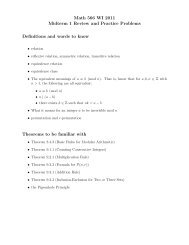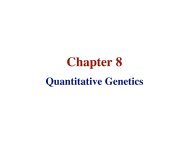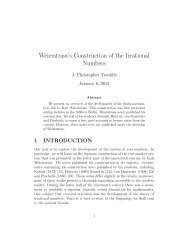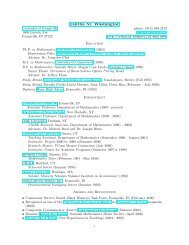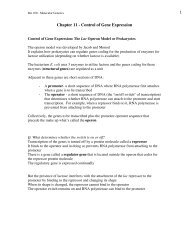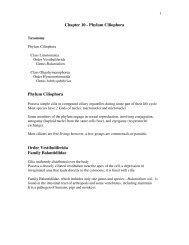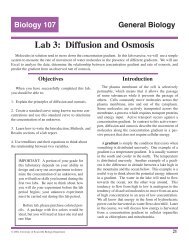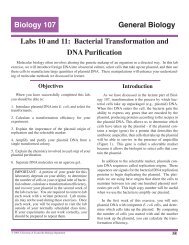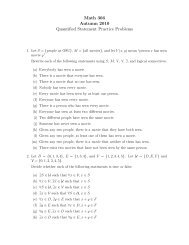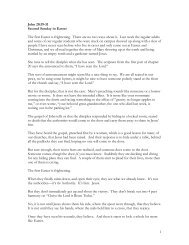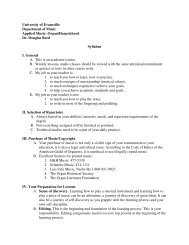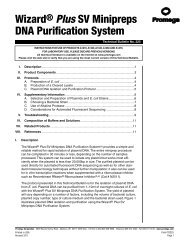Yersinia Virulence Depends on Mimicry of Host Rho ... - ResearchGate
Yersinia Virulence Depends on Mimicry of Host Rho ... - ResearchGate
Yersinia Virulence Depends on Mimicry of Host Rho ... - ResearchGate
You also want an ePaper? Increase the reach of your titles
YUMPU automatically turns print PDFs into web optimized ePapers that Google loves.
Figure 2. The YpkA-Rac1 Interface(A) Ribb<strong>on</strong> diagram view <strong>of</strong> the C<strong>on</strong>tact A interacti<strong>on</strong> between YpkA and Rac1. Switch I (yellow) and Switch II (red) are highlighted, and GDP is noted.(B) The image in panel (A) rotated by 90 about a horiz<strong>on</strong>tal axis.(C) Close up <strong>of</strong> the Switch I interacti<strong>on</strong>s with the a6 helix <strong>of</strong> YpkA. Hydrogen b<strong>on</strong>ds are denoted by dashed red lines.(D) Close up <strong>of</strong> the Switch II interacti<strong>on</strong>s with the a5 and a6 helices <strong>of</strong> YpkA. Hydrogen b<strong>on</strong>ds are denoted by dashed red lines.(E) Schematic <strong>of</strong> the interacti<strong>on</strong>s <strong>of</strong> the a5 and a6 helices <strong>of</strong> YpkA with Switch I and Switch II <strong>of</strong> Rac1. Hydrogen b<strong>on</strong>ds are indicated by red linesbetween the interacting residues, and hydrophobic interacti<strong>on</strong>s are shown with a yellow background.and (4) a heterodimer appears to be the biological unit asjudged by biochemical experiments (Figures 3 and S2).The overall structure <strong>of</strong> YpkA (434–732) reveals an el<strong>on</strong>gated,all-helical molecule c<strong>on</strong>sisting <strong>of</strong> two distinct subdomainsc<strong>on</strong>nected by a 65 Å l<strong>on</strong>g ‘‘backb<strong>on</strong>e’’ or ‘‘linkerhelix’’ (Figures 1A and 1B). The N-terminal subdomainc<strong>on</strong>tains most <strong>of</strong> the sequence-identified, ACC fingerlikerepeats that resemble, at the sequence level, elementsrequired in host factors for small GTPase binding,whereas the C-terminal subdomain c<strong>on</strong>tains the sequenceimplicated in actin activati<strong>on</strong>. The overall surface<strong>of</strong> the molecule is highly charged, c<strong>on</strong>taining a large basicpatch in the GTPase binding domain and a large acidicpatch in the actin-activati<strong>on</strong> domain (Figure S3).Despite apparent sequence similarities, the N-terminalsubdomain <strong>of</strong> YpkA (residues 434–615) does not sharethe coiled-coil fold <strong>of</strong> host ACC fingers, but instead it c<strong>on</strong>sists<strong>of</strong> six helices organized into two three-helix bundlespacked against each other. Each <strong>of</strong> the bundles is stabilizedby hydrophobic zippering in the core, and extensivehydrophobic packing is observed between the bundles.The previously identified regi<strong>on</strong>s harboring sequencesimilarity with ACC fingers (Dukuzumuremyi et al., 2000;Maesaki et al., 1999a, 1999b) are not involved in theYpkA-Rac1 interface. The far C-terminal subdomain <strong>of</strong>YpkA, c<strong>on</strong>taining the polypeptide implicated in actin activati<strong>on</strong>(residues 705–732, corresp<strong>on</strong>ding to helix a10), isa novel and el<strong>on</strong>gated fold c<strong>on</strong>sisting <strong>of</strong> four helices clusteredinto two pairs that <strong>on</strong>ly moderately interact with eachother. The a10 helix (residues 705–730) encompasses thepeptide that had been predicted to play a role in the interacti<strong>on</strong><strong>of</strong> YpkA with actin, and past work has shown thatthe deleti<strong>on</strong> <strong>of</strong> the regi<strong>on</strong> eliminates both the ability <strong>of</strong>YpkA to bind to actin and kinase activity (Juris et al.,2000). This helix forms an integral part <strong>of</strong> the fold <strong>of</strong> thissubdomain, c<strong>on</strong>tributing a large number <strong>of</strong> n<strong>on</strong>polarresidues to its hydrophobic core.There are very few c<strong>on</strong>formati<strong>on</strong>al changes betweenYpkA (434–732) crystallized al<strong>on</strong>e and YpkA (434–732) incomplex with Rac1 (Figure S3). Most differences arelocated in the C-terminal subdomain <strong>of</strong> YpkA and involvea slight overall displacement in the positi<strong>on</strong>ing <strong>of</strong> the a7and a8 helices, as well as alterati<strong>on</strong>s in the c<strong>on</strong>formati<strong>on</strong>and relative disorder <strong>of</strong> solvent exposed loops. Rac1 islittle altered by the binding <strong>of</strong> YpkA except for in theSwitch regi<strong>on</strong>s as discussed below.The YpkA-Rac1 InterfaceYpkA and Rac1 form an interface burying roughly 1600 Å 2and limited to residues 573–601 <strong>of</strong> YpkA (spanning thehelices a5 and a6) c<strong>on</strong>tacting the key regulatory Switch Iand Switch II regi<strong>on</strong>s <strong>of</strong> Rac1 (Figures 2A–2E). Switch Iand Switch II together create a c<strong>on</strong>cave pocket into whichthe a6 (backb<strong>on</strong>e) helix <strong>of</strong> YpkA inserts (Figure 2B), which,al<strong>on</strong>g with the clustering <strong>of</strong> the Switch II helix with the a5and a6 helices, cement the interacti<strong>on</strong> tightly.Cell 126, 869–880, September 8, 2006 ª2006 Elsevier Inc. 871



